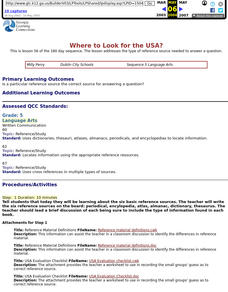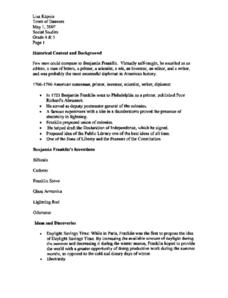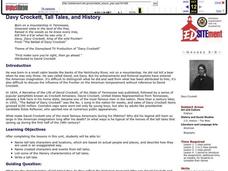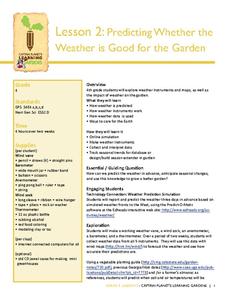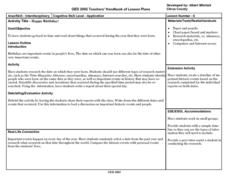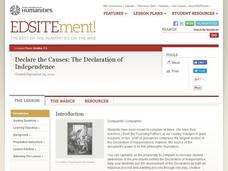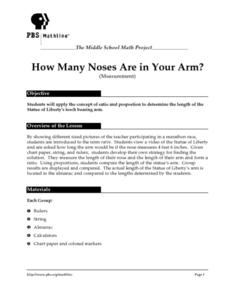Curated OER
Where to Look for the USA?
Fifth graders, in groups, explore the the type of reference sources are needed to answer a question. Each group identifies where the material was located, and the teacher records the guess.
Curated OER
Using Information Resources: Lesson 1
Eighth graders examine, brainstorm, cluster, and skim how to use a variety of information resources to assist them in projects or reports. In addition, places to find those information resources as well as the parts of a book is covered...
Curated OER
Presidents
Fifth graders use almanacs to take notes on their individual presidents on a note card. They fill in a variety of biographical information on their president. They convert their information into whole paragraphs.
Curated OER
Being a Good Detective
Students examine a variety of reference resources when seeking information. They discuss atlases, almanacs, dictionaries, encyclopedias, thesauri, online search engines for the Internet, and online library card catalogs. They complete a...
Curated OER
Glossary, Index, and Table of Contents
Fourth graders use two separate sources to learn about index, glossary, and table of contents usage. In this library lesson, 4th graders use two books, Learning About Weather with Graphic Organizers, and The World Almanac for Kids, to...
Curated OER
Celebrating Benjamin Franklin
Pupils explore various websites featuring the life and achievements of Benjamin Franklin. They investigate Franklin's roles in colonial society as well as pictures of his various inventions. They view excerpts of historical documents...
Curated OER
Agriculture is a Cycle
What do a bicycle and the life cycle have in common? Cover this and more with the series of cross-curricular activities included in this plan. Learners do everything from making bracelets that represent the life cycle to checking out the...
Curated OER
Poor Richard's Almanack
Students discover what "Poor Richard's Almanack" is and identify at least one element of good writing used by Benjamin Franklin and his work. They then identify what makes some of Benjamin Franklin's sayings applicable today and create a...
Benjamin Franklin Tercentenary
B. Franklin, Printer and the Public Eye
Students explore U.S. history by researching famous Americans. In this Benjamin Franklin lesson plan, students read portions of a biography about Franklin and identify his position within U.S. politics and as a leader in the battle for...
Curated OER
Songs of Protest/Songs of Unity: 1865 to the Present
Students study song-poems from 1865 to the present. They explore the works of Woody Guthrie and the Almanac Singers (including Pete Seeger).
Curated OER
Virginia In the World: The Geography of Commerce
Middle schoolers examine how Virginia connects with the world through export trade. Using a map, they use symbols to depict the value of trade and the direction of the flow of goods. They complete a scavenger hunt using electronic...
Curated OER
LET'S TRADE
The students will become familiar with the methods used to trade agricultural products between countries.1. Allow students to research the trade embargoes the United States has imposed on other countries.
2. Use encyclopedias and...
Curated OER
A New Era for Palestinians
Get a global perspective and examine the challenges facing Mahmoud Abbas, the newly elected president of the Palestinian Authority. Thoughtful classroom citizens write letters to Mr. Abbas, asking him questions and suggesting advice....
Curated OER
Born on a Mountaintop? Davy Crockett, Tall Tales, and History
Learners compare and contrast the details from the life of the real David Crockett and the legendary folk hero he later became. They identify the characteristics of a tall tale and follow a rubric to create a tall tale of their own.
Curated OER
New York City Delights: The Taxi Cab
You set the rate! Step into the shoes of a taxi driver in New York City, and also pretend to be a person who uses taxis to get around town. The class will conduct collaborative research to learn about the history of taxis. Then, they...
Curated OER
Ben Franklin Timeline
Celebrate inventions such as lightning rods, bifocals, and stoves with a Ben Franklin Day. Young historians conduct research and write a paragraph about an accomplishment of Benjamin Franklin including an illustration or collage that...
Curated OER
City, County, Community
Students explore issues and situations that make for a city and its local environments. In this local government lesson, students design maps, define issues and create brochures that illustrate their understandings of these concepts and...
Captain Planet Foundation
Predicting Whether the Weather is Good for the Garden
Can your class predict the weather? Show them how they can come close with a lesson about creating weather instruments, including weather vanes, barometers, wind socks, anemometers, and thermometers. Kids research weather patterns and...
Curated OER
Happy Birthday!: Internet Research and Historic Events
Talk about intrinsic motivation! Begin where your students' natural interests lie -- with themselves -- and launch a variety of projects with this activity. Class members research important events that took place on their birthdays....
Curated OER
Locating Information Quickly in a Variety of Resources
Here is a lesson which may be best suited for a library science teacher, or one that can be done by a regular teacher when in the library. In it, learners explore the best ways to use print and electronic resources to find information...
Curated OER
European Elevation Sort
Given a prepared database of European countries, sixth graders sort the countries in ascending order by elevation and identify the five countries with the highest elevations. This cross-curricular activity combines elements of computer...
Curated OER
Making a Cartogram
Students interpret statistical geographic information by creating a cartogram.
Curated OER
Declare the Causes: The Declaration of Independence
Students study the Declaration of Independence and the process our founding fathers went through to get it written and signed. They analyze other similar historical documents and draft and present their own declarations.
Curated OER
How Many Noses Are in Your Arm?
Middle schoolers apply concept of ratio and proportion to determine length of Statue of Liberty's torch-bearing arm. They view video of Statue of Liberty, determine how long statue's arm would be if its nose measures four feet six...
Other popular searches
- Encyclopedias & Almanacs
- Poor Richard's Almanac
- Almanac Lesson Plans
- World Almanac
- Using an Almanac
- Almanac Skills
- Atlas and Almanac
- World Almanac for Kids
- How to Use Almanacs
- Atlas Almanac
- Almanac Worksheet
- Using Almanacs


